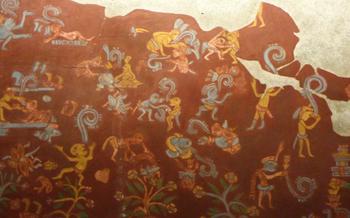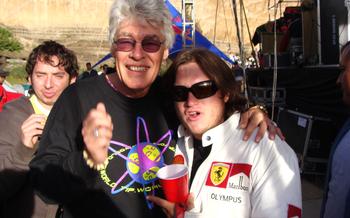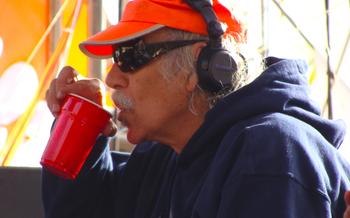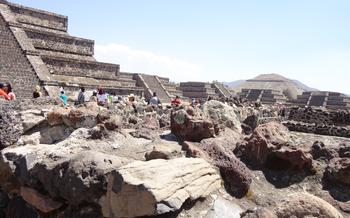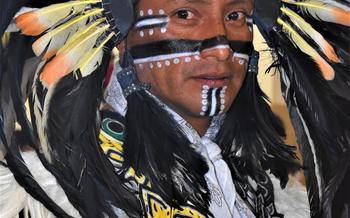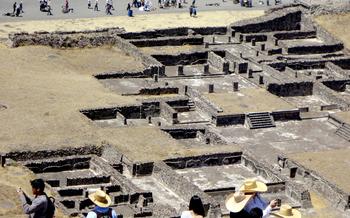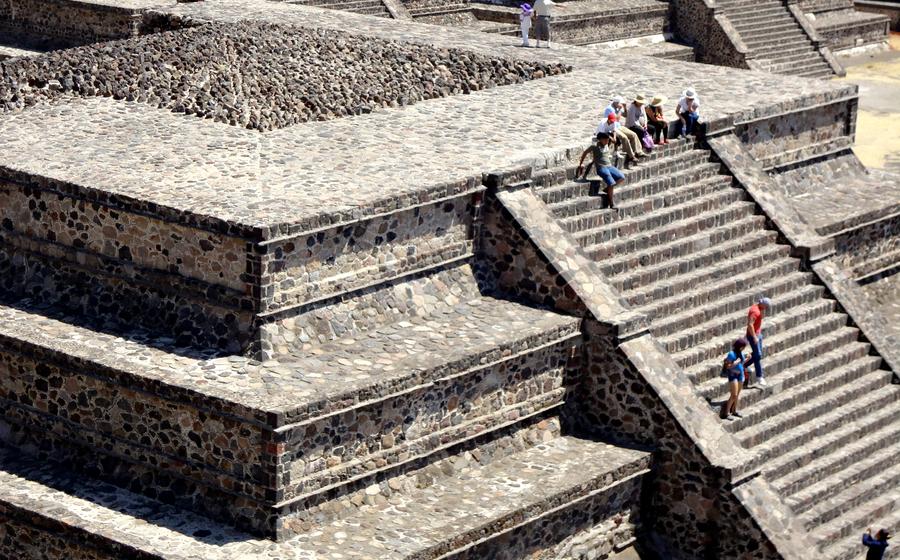
Oxtotipac Monastery
- A Monumental Complex in the Valley of Mexico
- Excavating the Past: The Discovery of Oxtotipac
- Exploring the Monastery's Layout:
- Artistic Masterpieces: Murals and Paintings
- A Center of Rituals and Ceremonies
- Daily Life in the Monastery
- The Fall of Teotihuacan and the Monastery's Fate
- Visiting the Oxtotipac Monastery Today:
- Unveiling the Secrets of the Teotihuacan Codex
- The Role of Water in Teotihuacan's Urban Design
- Astronomical Alignments and Celestial Observations
- The Influence of Teotihuacan on Mesoamerican Cultures:
- Ongoing Archaeological Research and Discoveries
- Insider Tip:
A Monumental Complex in the Valley of Mexico
Teotihuacan, an ancient city in central Mexico, stands as a testament to the ingenuity and cultural achievements of its inhabitants. Within this sprawling metropolis, the Oxtotipac Monastery emerges as a monumental complex of profound historical and religious significance. Situated in the heart of the Valley of Mexico, Teotihuacan flourished between 100 BC and 650 AD, leaving behind a legacy of architectural wonders, including the Pyramid of the Sun, the Pyramid of the Moon, and the Avenue of the Dead. Among these iconic structures, the Oxtotipac Monastery holds a unique and captivating allure.
The monastery complex, with its imposing presence and intricate design, offers a glimpse into the spiritual and ceremonial life of the Teotihuacan people. Its architectural style, characterized by massive stone platforms, intricately carved facades, and vibrant murals, reflects the city's advanced construction techniques and artistic prowess. The complex's strategic location, nestled amidst ceremonial plazas and residential neighborhoods, underscores its central role in the religious and civic life of Teotihuacan.
The Oxtotipac Monastery embodies the city's intricate belief system and deep connection to the cosmos. Its structures, arranged in a harmonious layout, were meticulously aligned with celestial events and served as sacred spaces for rituals, offerings, and ceremonies. The complex's enduring presence stands as a testament to the enduring legacy of Teotihuacan's rich cultural and spiritual heritage.
Excavating the Past: The Discovery of Oxtotipac
The discovery of the Oxtotipac Monastery was a significant moment in the archaeological exploration of Teotihuacan. In 1964, Mexican archaeologist Jorge Acosta began excavations at the site, revealing the remains of a vast and intricate complex. The excavation process presented numerous challenges, as the structures were buried deep underground and intertwined with vegetation.
Through careful and meticulous work, Acosta and his team uncovered the monastery's layout, including temples, workshops, and living quarters. These discoveries provided valuable insights into the daily lives and rituals of the Teotihuacan people. The excavation also revealed numerous artifacts, such as ceramics, obsidian tools, and figurines, which shed light on the economic and cultural activities that took place within the monastery.
The preservation of the Oxtotipac Monastery has been a priority for archaeologists and conservationists. Extensive efforts have been made to stabilize the structures, restore the murals, and protect the site from further deterioration. These efforts have ensured that the monastery remains a testament to the ingenuity and artistry of the Teotihuacan civilization.
Exploring the Monastery's Layout:
The Oxtotipac Monastery is an intricate complex featuring a well-organized layout and various structures that served diverse purposes. The complex revolves around central plazas and courtyards, which were significant gathering places and venues for ceremonial activities. These open spaces allowed for community interactions and facilitated religious rituals.
Within the monastery, one can find temples dedicated to various deities, each showcasing unique architectural features and symbolic elements. The temples were adorned with elaborate murals and paintings, offering glimpses into the religious beliefs and mythology of the Teotihuacan people.
The monastery also included workshops where artisans engaged in crafting pottery, textiles, and other objects, contributing to the economic and cultural life of the community. In addition, living quarters provided accommodation for the monks and inhabitants of the monastery, creating a vibrant and self-sufficient community.
The interconnections between these various spaces highlight the functional nature of the monastery's layout, enabling seamless movement and interaction among its inhabitants. The careful planning and organization of the complex reflect the advanced urban planning skills of the Teotihuacan civilization.
Artistic Masterpieces: Murals and Paintings
Within the Oxtotipac Monastery's sacred walls, visitors are captivated by the exquisite murals and paintings that adorn its chambers. These artworks, created with remarkable skill and precision, offer a glimpse into the vibrant world of Teotihuacan mythology and religious beliefs.
The murals, executed in a variety of techniques, showcase the mastery of Teotihuacan artists. From vibrant frescoes to intricate stucco reliefs, each mural tells a unique story, depicting gods, goddesses, mythical creatures, and scenes from daily life. The vivid colors, bold lines, and intricate details bring these ancient narratives to life, inviting viewers to immerse themselves in the rich tapestry of Teotihuacan's spiritual world.
One of the most striking murals depicts the Feathered Serpent Quetzalcoatl, a revered deity associated with creation, fertility, and wind. Quetzalcoatl is portrayed as a majestic serpent with vibrant green feathers, its body undulating gracefully across the wall. Other murals showcase scenes of human sacrifice, offering insights into the religious rituals and beliefs of the Teotihuacan people.
The Oxtotipac Monastery's murals are not merely decorative; they serve as powerful tools for communication and education. They convey religious teachings, reinforce social norms, and commemorate important historical events. By studying these artworks, scholars gain valuable insights into the complex belief system and cultural practices of Teotihuacan society.
Preservation efforts are paramount in ensuring that these priceless treasures remain intact for generations to come. Conservationists employ specialized techniques to stabilize and protect the murals from the ravages of time and environmental factors. Through their dedicated efforts, these vibrant masterpieces continue to captivate visitors, offering a glimpse into the rich artistic and spiritual heritage of the ancient Teotihuacan civilization.
A Center of Rituals and Ceremonies
The Oxtotipac Monastery held a significant role as a religious center within the ancient city of Teotihuacan. It served as a sacred space for various rituals and ceremonies that were integral to the spiritual life of the Teotihuacan people.
Archaeological evidence suggests that the monastery was a site of numerous religious practices. Elaborate rituals, including offerings and sacrifices, were performed within the complex. Excavations have uncovered a wealth of artifacts, such as incense burners, ceramic vessels, and animal remains, indicating the ritualistic nature of the site.
The central plazas and courtyards of the monastery provided ample space for gatherings and ceremonial activities. These open areas likely hosted religious festivals, processions, and other sacred events that brought the community together.
The monastery's unique architectural features, such as the central pyramid and the surrounding structures, were designed to facilitate these rituals. The pyramid itself may have served as a platform for religious ceremonies, with priests or rulers performing rituals at its summit.
The Oxtotipac Monastery stands as a testament to the deep religious beliefs and practices of the Teotihuacan people. Its significance as a center of rituals and ceremonies offers valuable insights into the spiritual dimension of this ancient Mesoamerican civilization.
Daily Life in the Monastery
The Oxtotipac Monastery was not merely a place of religious rituals and ceremonies; it was also a vibrant community where people lived, worked, and interacted. Archaeological excavations have provided glimpses into the daily lives of the monks and inhabitants who called the monastery home.
Economic Activities: The monastery was an economically self-sufficient entity, with its inhabitants engaging in various activities to sustain themselves. Farming was a primary occupation, with fields surrounding the complex where crops such as maize, beans, and squash were cultivated. Trade was another important economic activity, as the monastery's location along trade routes facilitated the exchange of goods with other regions.
Social Interactions and Community Life: The monastery fostered a strong sense of community among its inhabitants. People lived in shared quarters, likely organized according to their roles and responsibilities within the monastery. Social interactions were an integral part of daily life, with communal meals, gatherings, and celebrations bringing the community together.
Education and Knowledge Transmission: The monastery served as a center for education and knowledge transmission. It is believed that the monks were responsible for educating young boys in various subjects, including religious teachings, writing, and mathematics. The monastery's extensive collection of murals and paintings also played a role in educating the community about religious beliefs and historical events.
The Oxtotipac Monastery was a microcosm of Teotihuacan society, reflecting the city's economic, social, and intellectual life. By studying the daily lives of the monastery's inhabitants, we gain a deeper understanding of the complex and vibrant culture that flourished in ancient Teotihuacan.
The Fall of Teotihuacan and the Monastery's Fate
The once-thriving city of Teotihuacan eventually met its demise, and the Oxtotipac Monastery, like many other structures, was abandoned. The reasons behind the city's collapse remain a mystery, but several theories have been proposed. Some suggest that internal conflicts, environmental factors, or a combination of both led to the downfall of Teotihuacan. The city's population may have outgrown its resources, leading to social unrest and political instability. Additionally, prolonged droughts or climate change could have contributed to agricultural decline and economic disruption.
The abandonment of the Oxtotipac Monastery marked the end of an era, as the complex ceased to function as a religious and cultural center. The once-bustling monastery fell into disrepair, and its structures were gradually reclaimed by nature. Over time, the monastery became buried under layers of soil and vegetation, hidden from the eyes of the world until its rediscovery in the 20th century.
Despite its abandonment, the Oxtotipac Monastery remains a testament to the ingenuity and artistry of the Teotihuacan people. Its enduring legacy continues to captivate scholars and visitors alike, offering valuable insights into the rise and fall of one of the most influential civilizations in Mesoamerican history.
Visiting the Oxtotipac Monastery Today:
Practical Information and Tips for an Enriching Experience
Opening Hours and Admission Fees: - The Oxtotipac Monastery is open to visitors from Tuesday to Sunday, from 9 am to 5 pm. - Admission fees are affordable and typically include access to the entire Teotihuacan Archaeological Zone. - Discounts and concessions may be available for students, seniors, or groups.
Accessibility and Transportation: - The monastery is located within the Teotihuacan Archaeological Zone, about 50 kilometers northeast of Mexico City. - Easily accessible by car, taking the Mexico City-Querétaro highway and following signs to Teotihuacan. - Public transportation options are also available, such as buses or guided tours departing from Mexico City.
Guided Tours and Self-Guided Exploration: - Guided tours in various languages are offered at the site, providing insights into the history, architecture, and significance of the monastery. - For a more independent experience, visitors can opt for self-guided exploration using guidebooks, maps, or audio guides.
Tips for Making the Most of Your Visit: - Arrive early in the morning to avoid crowds and enjoy the cooler temperatures, especially during the summer months. - Wear comfortable shoes as the monastery complex involves walking on uneven surfaces. - Bring water, sunscreen, and a hat to protect yourself from the sun. - Cameras are allowed, but flash photography is prohibited to preserve the integrity of the artworks.
Unveiling the Secrets of the Teotihuacan Codex
In addition to the physical remains of Teotihuacan, another invaluable source of information about the city's history and culture is the Teotihuacan Codex. Discovered in the mid-20th century, this ancient manuscript offers a glimpse into the lives, beliefs, and rituals of the Teotihuacan people.
The codex is a collection of painted pages made from amate paper, a type of bark paper used by pre-Columbian Mesoamerican cultures. The manuscript contains a wealth of information, including genealogies of rulers, historical events, and religious ceremonies. It also features intricate drawings and symbols that provide insights into Teotihuacan's mythology and cosmology.
Interpreting the codex has been a challenging task for scholars due to its fragmentary nature. Many of the pages are damaged or missing, and the writing system used by the Teotihuacan people is not fully understood. Despite these challenges, ongoing research and efforts to piece together the codex's contents are providing valuable insights into the history and culture of this ancient civilization.
The Teotihuacan Codex is a priceless treasure that offers a unique perspective on one of the most influential civilizations in Mesoamerica. By studying and deciphering this ancient manuscript, researchers continue to uncover the secrets of Teotihuacan and shed light on the lives of its people.
The Role of Water in Teotihuacan's Urban Design
Water played a crucial role in Teotihuacan's urban design and daily life. The city's inhabitants demonstrated remarkable ingenuity in managing and utilizing water resources. Evidence of canals, reservoirs, and aqueducts has been found throughout the city, including near the Oxtotipac Monastery. These hydraulic systems served multiple purposes, from supplying water for domestic use and irrigation to facilitating religious rituals and ceremonies.
The Teotihuacans constructed an elaborate network of canals that channeled water from distant springs and rivers into the city. These canals not only provided a reliable water supply but also helped to control flooding and maintain a balanced water table. The city's reservoirs, strategically located to collect and store rainwater, ensured a steady water supply during the dry season.
Water held deep religious significance for the Teotihuacans. They believed that water was a sacred element associated with fertility, life, and renewal. Water played a central role in many religious rituals and ceremonies, including those related to agriculture and the worship of water deities. The presence of water features, such as fountains and pools, within the Oxtotipac Monastery complex further underscores the importance of water in Teotihuacan's religious practices.
The Teotihuacans' advanced water management practices extended beyond the city's immediate surroundings. They constructed terraces and irrigation systems in the surrounding hills to improve agricultural yields. By carefully managing water resources, the Teotihuacans were able to sustain a large population and create a thriving urban center in a semi-arid region.
The Teotihuacans' water management practices stand as a testament to their ingenuity and adaptability. Their sustainable approach to water resource management ensured the city's prosperity and left a lasting legacy that continues to inspire modern water management strategies.
Astronomical Alignments and Celestial Observations
The Oxtotipac Monastery is believed to have been aligned with significant astronomical events, such as solstices and equinoxes. This alignment suggests that the Teotihuacan people possessed advanced knowledge of astronomy and used celestial observations for religious and practical purposes. It is possible that the monastery complex included structures or spaces specifically designed for astronomical observations or timekeeping. The integration of astronomical knowledge into the design and orientation of Teotihuacan's buildings demonstrates the sophistication and precision of their urban planning. Understanding the astronomical significance of the Oxtotipac Monastery provides valuable insights into the religious beliefs and scientific achievements of the Teotihuacan civilization.
The Influence of Teotihuacan on Mesoamerican Cultures:
Teotihuacan's influence extended far beyond its physical boundaries, leaving an indelible mark on the cultural landscape of Mesoamerica. Through trade networks and cultural exchanges, Teotihuacan's ideas, artistic styles, and religious practices spread throughout the region.
Similarities and connections can be found between Teotihuacan and other major Mesoamerican cities, such as Cholula and Monte Albán. These cities adopted Teotihuacan's architectural styles, iconography, and even some of its religious beliefs. The influence of Teotihuacan can be seen in the construction of large pyramids, the use of talud-tablero facades, and the depiction of certain deities.
The enduring legacy of Teotihuacan's cultural and artistic achievements can still be seen in modern-day Mexico. Many of the traditions and beliefs that originated in Teotihuacan continue to shape Mexican culture and identity. The city's impact on Mesoamerica is a testament to its profound influence on the development of one of the world's richest and most diverse civilizations.
Ongoing Archaeological Research and Discoveries
Archaeological research at the Oxtotipac Monastery and throughout Teotihuacan is an ongoing process, with new findings and insights emerging regularly. Recent excavations have uncovered hidden chambers, artifacts, and other valuable clues that shed light on the ancient city's history and culture.
Archaeologists continue to study the monastery complex, using advanced techniques such as ground-penetrating radar and 3D scanning to gain a deeper understanding of its structures and layout. These efforts have revealed new details about the monastery's construction, modifications, and usage over time.
Ongoing research also focuses on understanding the daily lives of the monks and inhabitants of the monastery. Archaeologists are studying the complex's economic activities, social interactions, and the role of the monastery as a center for education and knowledge transmission.
Visitors to the Oxtotipac Monastery have the opportunity to learn about the latest archaeological discoveries and research projects through guided tours or workshops. These tours often provide exclusive access to excavation sites and offer insights into the ongoing work of archaeologists.
Insider Tip:
To make your visit to the Oxtotipac Monastery even more enriching, consider exploring the nearby Teotihuacan Archaeological Zone, a UNESCO World Heritage Site. Immerse yourself in the grandeur of the iconic pyramids, such as the Pyramid of the Sun and the Pyramid of the Moon, and marvel at the intricate carvings and murals that adorn them. Wander through the ancient streets and plazas, and let your imagination transport you back in time to the bustling metropolis that was once Teotihuacan.
Plan your visit to the Oxtotipac Monastery and the Teotihuacan Archaeological Zone during the spring or fall to avoid the scorching summer heat. This will allow you to comfortably explore these awe-inspiring sites without compromising your enjoyment. Embrace the opportunity to delve into the rich history and cultural legacy of Teotihuacan, and create lasting memories that will stay with you long after your visit.
